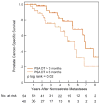The natural history of noncastrate metastatic prostate cancer after radical prostatectomy
- PMID: 17125912
- PMCID: PMC2646889
- DOI: 10.1016/j.eururo.2006.10.045
The natural history of noncastrate metastatic prostate cancer after radical prostatectomy
Abstract
Objectives: To characterise the natural history of metastatic prostate cancer after radical prostatectomy (RP) in patients followed expectantly for rising prostate-specific antigen (PSA) (noncastrate metastases).
Methods: Cox proportional hazards analyses were used to assess predictors of survival among 95 patients who developed clinically detectable noncastrate metastases after RP. The initial metastatic phenotype was characterised as minimal (nodal or axial skeletal involvement) or extensive (appendicular skeletal involvement or visceral metastases). Estimates of survival after diagnosis of metastases were generated with the Kaplan-Meier method.
Results: Median disease-specific survival from diagnosis of noncastrate metastases was 6.6 yr (95% confidence interval [CI], 5.2, 7.9). The initial site of metastatic disease was bone, lymph node, and viscera in 63%, 36%, and 6% of patients, respectively. Thirteen patients (14%) had extensive disease at their first metastatic manifestation. Longer PSA doubling time in the rising PSA state (hazard ratio [HR] 0.8 for each month increase in doubling time; 95%CI, 0.67-0.94) and the initial metastatic phenotype (HR 0.3 for minimal vs. extensive disease; 95%CI, 0.1-0.6) were associated with improved survival. The prostatectomy Gleason score, lymph node status at RP, PSA level at diagnosis of metastases, and interval from surgery to diagnosis of metastases did not correlate with outcome.
Conclusion: Men who develop noncastrate metastases after RP may have a durable survival. Favourable prognostic indicators include longer PSA doubling time preceding diagnosis of metastases and initial involvement of axial skeleton or lymph nodes.
Conflict of interest statement
Conflicts of interest
I hereby certify that all authors have made a substantial contribution to the information or material submitted for publication and have read and approved the final manuscript. The manuscript or portions thereof are not under consideration by another journal or electronic publication and have not been previously published.
Figures



References
-
- Pound CR, Partin AW, Eisenberger MA, Chan DW, Pearson JD, Walsh PC. Natural history of progression after PSA elevation following radical prostatectomy. JAMA. 1999;281:1591–7. - PubMed
-
- Loblaw DA, Mendelson DS, Talcott JA, et al. American Society of Clinical Oncology recommendations for the initial hormonal management of androgen-sensitive metastatic, recurrent, or progressive prostate cancer. J Clin Oncol. 2004;22:2927–41. - PubMed
-
- Bolla M, Collette L, Blank L, et al. Long-term results with immediate androgen suppression and external irradiation inpatientswithlocally advancedprostatecancer(anEORTC study): a phase III randomised trial. Lancet. 2002;360:103–6. - PubMed
-
- Messing EM, Manola J, Sarosdy M, Wilding G, Crawford ED, Trump D. Immediate hormonal therapy compared with observation after radical prostatectomy and pelvic lymphadenectomy in men with node-positive prostate cancer. N Engl J Med. 1999;341:1781–8. - PubMed
-
- Moul JW, Wu H, Sun L, et al. Early versus delayed hormonal therapy for prostate specific antigen only recurrence of prostate cancer after radical prostatectomy. J Urol. 2004;171:1141–7. - PubMed
Publication types
MeSH terms
Grants and funding
LinkOut - more resources
Full Text Sources
Medical
Research Materials
Miscellaneous

